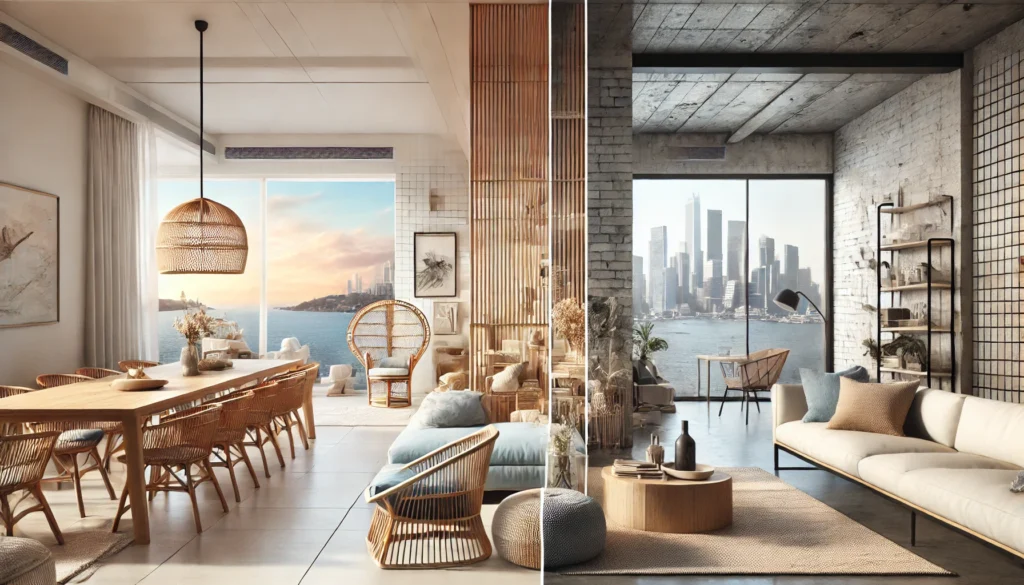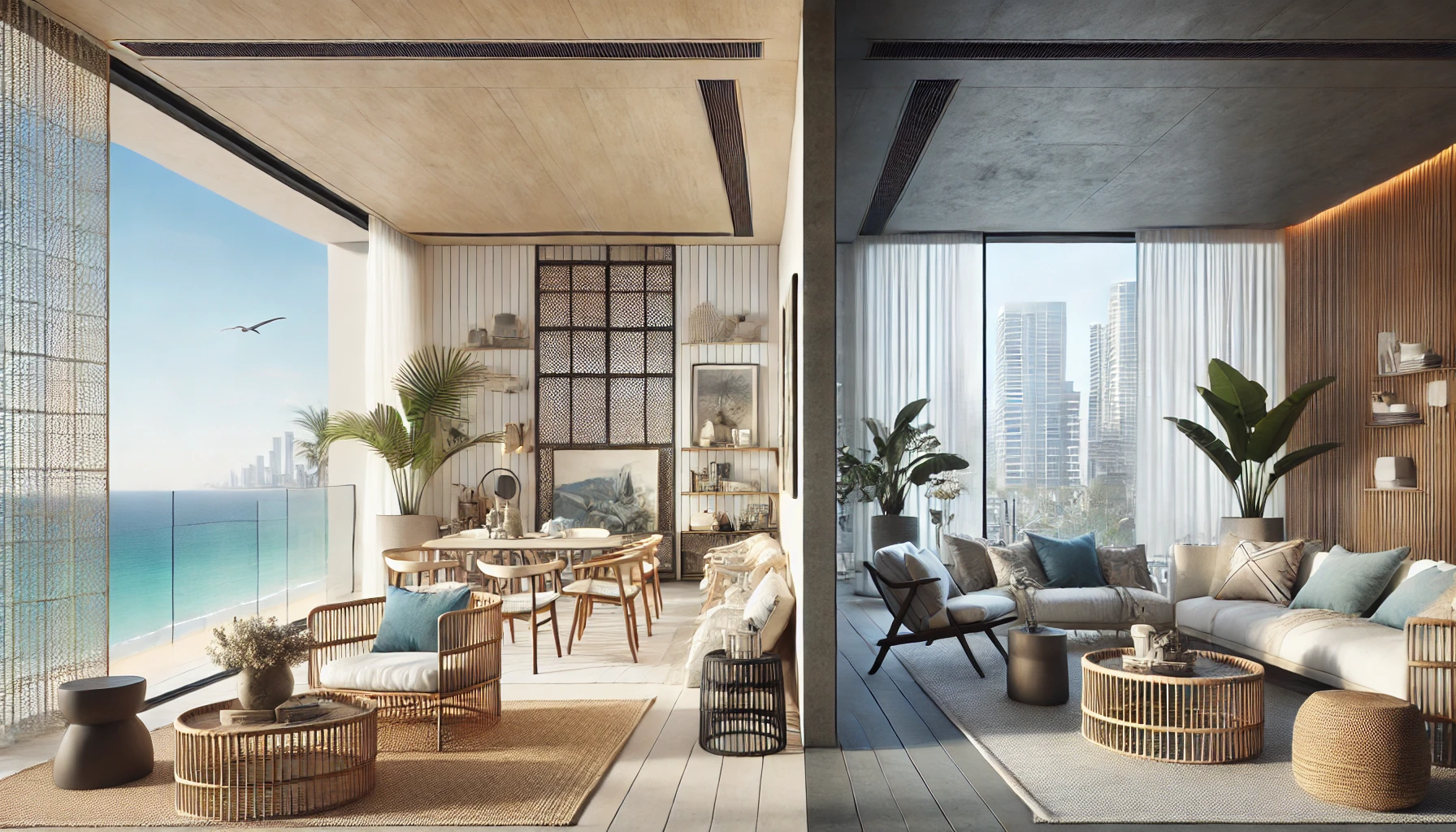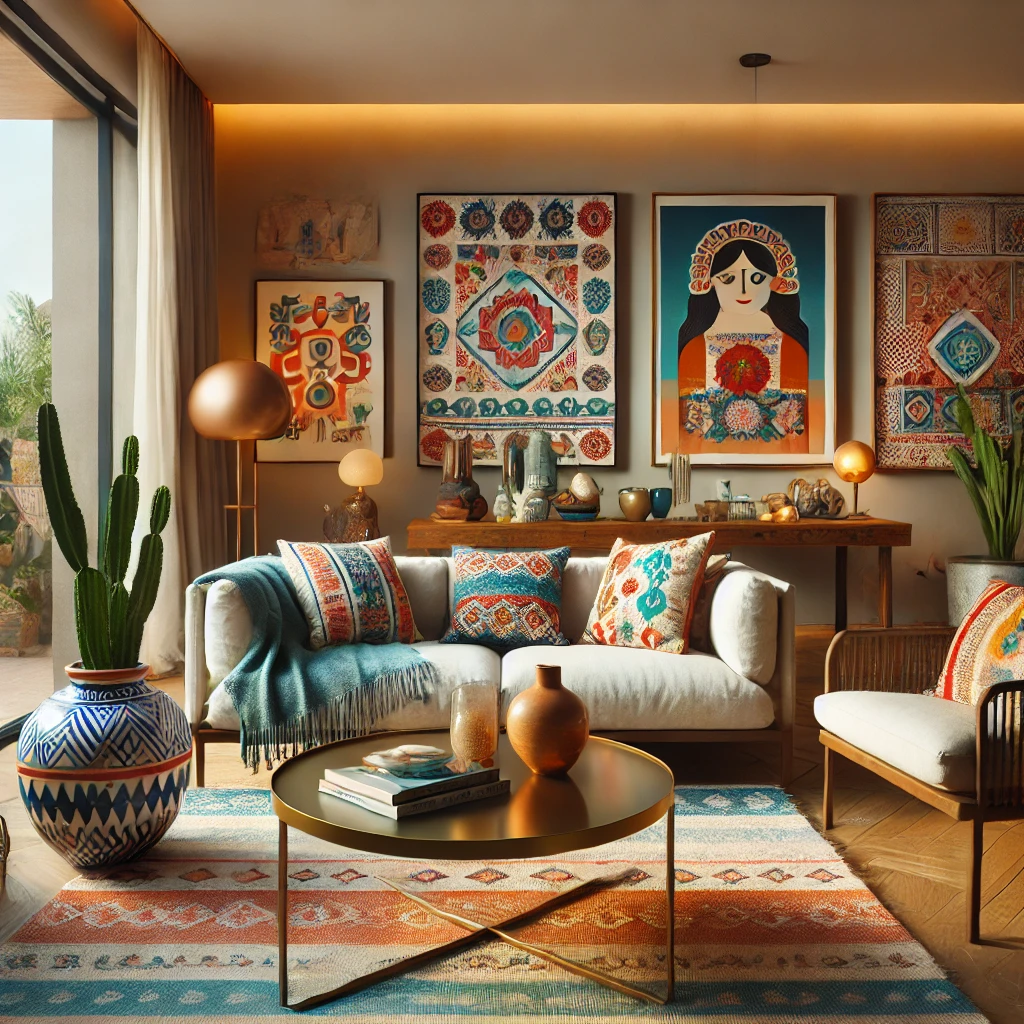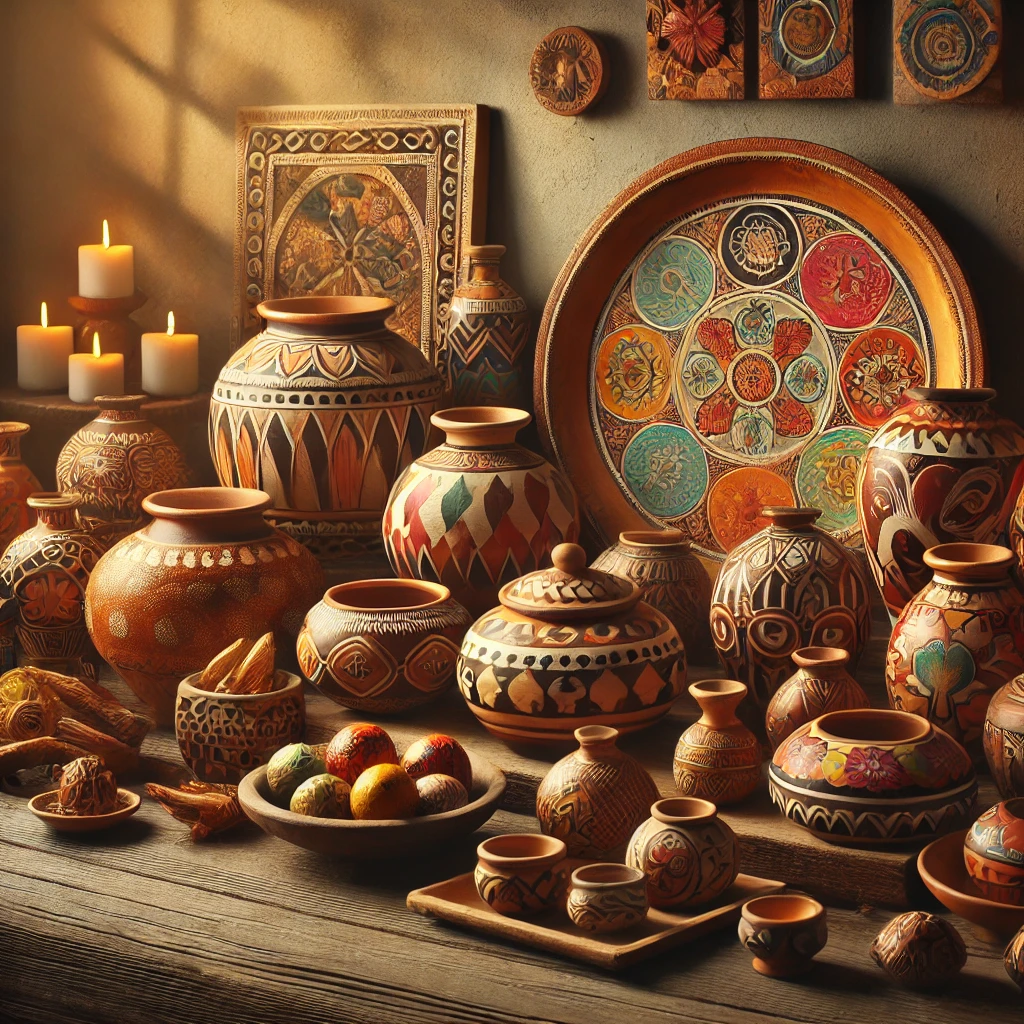Table of Contents
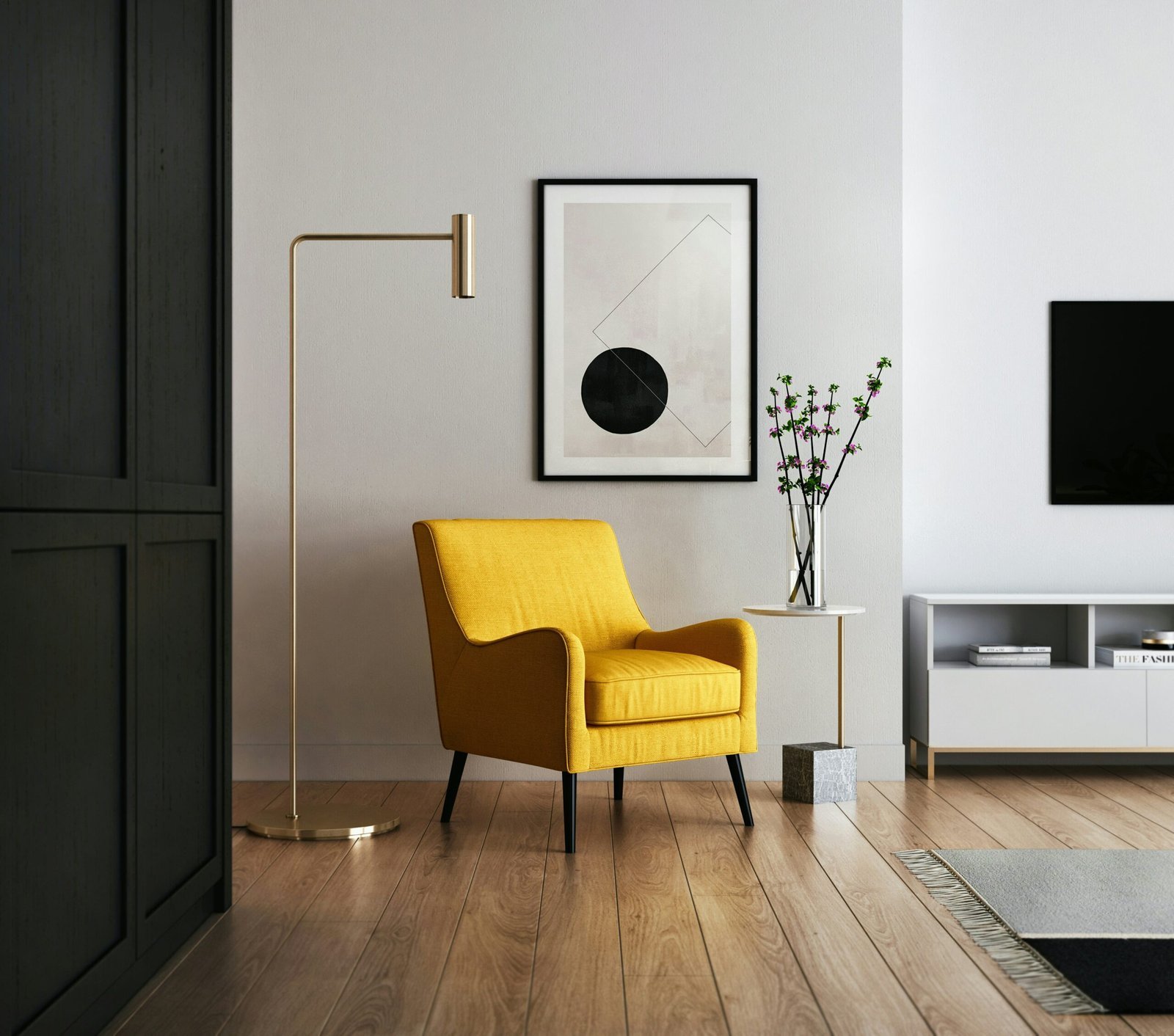
Overview of 2024 Interior Design Trends
As we step into 2024, the landscape of interior design in Australia is poised for an exciting transformation. This year promises a vibrant mix of styles, from the relaxed and airy ethos of coastal themes to the sleek sophistication of urban chic designs. A notable highlight is the renewed emphasis on natural materials, sustainability, and the creation of personalized spaces that reflect individual tastes and lifestyles. These trends mirror a deepening connection with nature and a growing awareness of environmental impacts.
The resurgence of natural materials is a defining element of 2024’s interior design trends. Incorporating elements such as timber, stone, and rattan not only enhances the aesthetic appeal but also promotes sustainability. Designers are increasingly opting for locally sourced materials, thereby reducing carbon footprints and supporting local artisans. This shift towards eco-friendly choices resonates with a broader movement towards environmental consciousness and responsible living.
In addition to sustainable materials, there’s a strong focus on creating personalized spaces tailored to the inhabitants’ needs and preferences. Homeowners are moving away from generic, one-size-fits-all designs and embracing bespoke solutions that add character and function to their homes. This trend underscores a desire to craft environments that offer comfort and reflect personal stories, making each space unique and meaningful.
Coastal vibes remain a perennial favorite in Australian interior design, characterized by a light and breezy aesthetic that embodies relaxation and tranquility. Think of soft color palettes, natural textures, and ample natural light that bring a sense of serenity indoors. On the other end of the spectrum, urban chic designs are gaining traction, featuring minimalist decor, clean lines, and industrial elements. This style appeals to those who appreciate a modern, sophisticated, and somewhat edgy look.
Overall, the interior design trends for 2024 celebrate a harmonious blend of nature and innovative design. They embrace sustainability without compromising on style, creating spaces that are not only beautiful but also environmentally responsible and uniquely personal. This coming year promises to be an exciting period for home makeovers, with plenty of inspiration to draw from these emerging trends.
Embracing Coastal Vibes
In the evolving landscape of Australian interior design trends, coastal vibes remain a perennial favorite, fostering a serene and breezy aesthetic that resonates with both city dwellers and beachside inhabitants. This trend continues to evolve, seamlessly blending the tranquility of the coast with contemporary nuances.
The foundation of coastal design lies in its light, neutral color palettes, which are often accented with hues of blue and green. These colors not only emote calmness but also mirror the natural beauty of Australia’s coastal regions. Whitewashed walls, soft beige tones, and subtle grey undertones create a canvas that highlights the airy and spacious essence of coastal interiors.
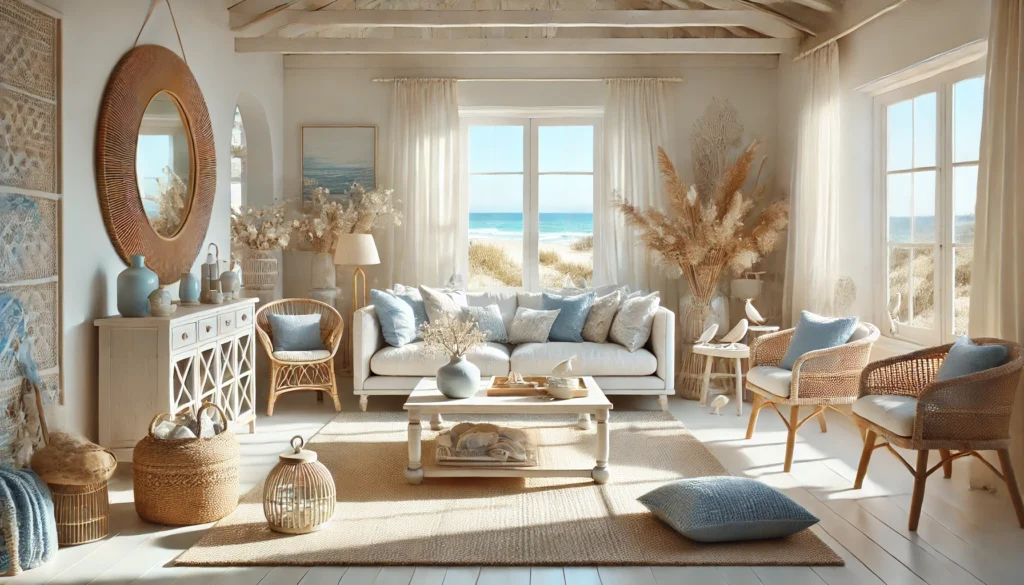
Natural textures play a pivotal role in embodying the coastal trend. Materials such as wood, rattan, and jute enhance the tactile experience, adding warmth and organic charm. Weathered timber flooring, rattan furniture, and jute rugs are quintessential pieces that bring the outdoors in, ensuring a connection to nature is always present within the home.
Indoor-outdoor living is a hallmark of Australian coastal design. This trend emphasizes large, open spaces that flow seamlessly from the interior to the exterior. Sliding glass doors, expansive windows, and patios adorned with comfortable outdoor furniture allow homeowners to enjoy the coastal climate and views year-round. Outdoor spaces often mirror the indoor aesthetic, featuring similar color schemes and materials to maintain a cohesive look.
Specific furniture pieces and decor items often define coastal interiors. Oversized linen sofas, wicker chairs, and wooden coffee tables are staples. These are typically complemented by decor elements such as nautical motifs, seashell embellishments, and marine-inspired artwork. The aim is to create a space that feels effortlessly relaxing, embodying the essence of a coastal retreat.
Overall, embracing coastal vibes in interior design trends is about capturing the laid-back elegance of seaside living, making it an enduring favorite in Australian homes.
Industrial Urban Chic
The industrial urban chic style, characterized by its edgy yet sophisticated appeal, has become a prominent trend in interior design for 2024. This aesthetic embodies the essence of contemporary urban living, melding the rawness of industrial elements with polished, modern touches to create spaces that are both functional and visually striking.
One of the hallmark features of industrial urban chic is the use of raw materials. These materials, such as metal, concrete, and exposed brick, lend an authentic, unpolished feel to the interiors. Metal beams and pipes, concrete floors, and walls with exposed brick all contribute to a rugged yet stylish environment that reflects an honest, stripped-back aesthetic.
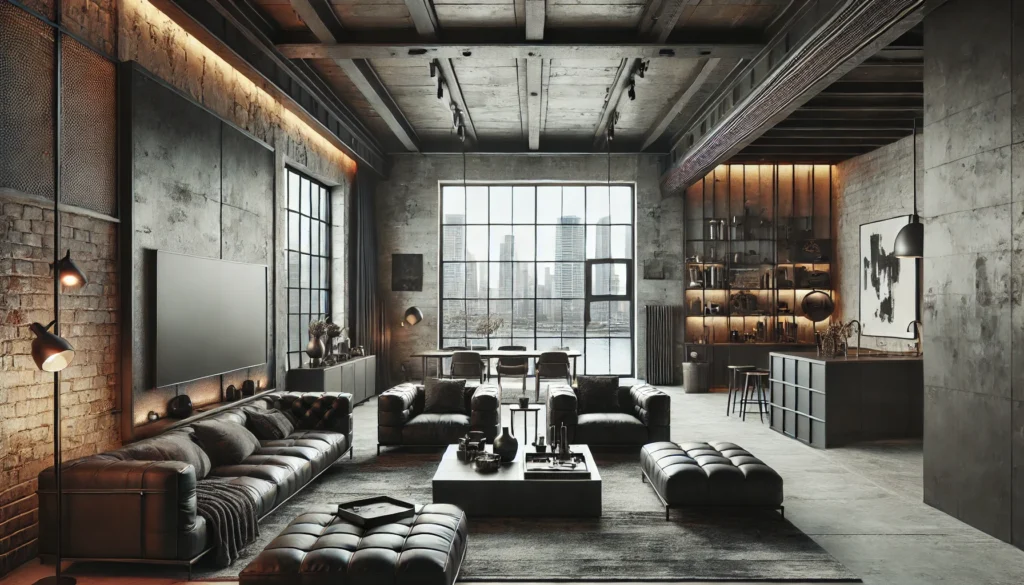
Complementing these raw materials is minimalist furniture, which ensures that the space remains uncluttered and functional. Pieces with clean lines and simple forms emphasize the beauty of the raw materials rather than competing with them. For instance, a sleek metal-framed sofa or a concrete coffee table can serve as statement pieces within this design framework.
Black accents play a crucial role in the industrial urban chic trend. Whether used in lighting fixtures, window frames, or furniture legs, black elements add depth and contrast, further enhancing the sophisticated yet edgy vibe of the space. These accents seamlessly tie together the diverse elements of the design, ensuring a cohesive look.
Modern technology is another integral aspect of this trend. Smart home solutions and state-of-the-art appliances blend effortlessly with the industrial materials, creating a juxtaposition that is both contemporary and practical. Think of a spacious open-plan kitchen with stainless steel appliances and a minimalist, concrete island as a perfect example of this balance.
To achieve a harmonious look, it is essential to balance the rugged elements with softer touches. Incorporating plush textiles, such as throw pillows, area rugs, and curtains, can soften the harshness of metal and concrete. Additionally, integrating greenery through indoor plants can bring a touch of nature to the urban environment, creating a welcoming and inviting ambiance.
In the realm of interior design trends, industrial urban chic stands out for its unique ability to merge the rugged with the refined. By thoughtfully blending raw materials with minimalist furniture, black accents, modern technology, and softer elements, one can create a space that is as stylish as it is functional.
Sustainable and eco-friendly designs have become a pivotal aspect of interior design trends in Australia, reflecting a broader global shift towards environmental responsibility. In 2024, the emphasis on sustainability continues to gain momentum, with Australian homes increasingly integrating eco-friendly practices to reduce their environmental footprint.
One of the prominent trends is the practice of upcycling, which involves repurposing old or discarded items into new, functional pieces. This not only adds a unique character to the interiors but also minimizes waste, promoting a circular economy. For instance, wooden pallets can be transformed into coffee tables or headboards, and vintage textiles can be reimagined as cushion covers or wall art.
The use of organic and recycled materials is another significant trend. Natural materials such as bamboo, cork, and reclaimed wood are favored for their minimal environmental impact. These materials bring warmth and texture to interior spaces while ensuring sustainability. Additionally, recycled glass and metal are being used to create stunning, contemporary fixtures and fittings.
Energy-efficient home systems are also becoming a staple in Australian interior design. Smart home technologies, such as programmable thermostats and energy-efficient lighting, help reduce energy consumption and lower utility bills. Solar panels and rainwater harvesting systems are other eco-friendly installations enhancing the sustainability of homes by utilizing renewable resources.
Several brands and designers are at the forefront of this sustainable movement. Sydney-based Koskela, known for their ethical production practices and use of sustainable materials, along with Melbourne’s EcoLuxe, which offers a range of eco-friendly furniture and homeware, are leading examples. Their innovative designs and commitment to eco-friendly practices set a benchmark for both industry professionals and homeowners.
Homeowners looking to make environmentally conscious choices can start by investing in quality, durable furniture that stands the test of time, thus reducing the need for frequent replacements. Opting for products with eco-certifications and supporting local artisans who use sustainable materials are other effective steps. Simple changes, such as using low-VOC paints and incorporating indoor plants, also contribute significantly to creating a healthier, more sustainable living environment.
Maximizing Small Spaces
In Australia’s bustling urban centers, efficient use of limited living space has become a pivotal aspect of interior design trends. To address this, modern design principles prioritize strategies that maximize the functionality and aesthetic appeal of smaller areas. One key approach is the incorporation of multi-functional furniture. Pieces like sofa beds, foldable tables, and ottomans with storage facilities enable spaces to serve multiple purposes without sacrificing style. These versatile items allow for seamless transitions between living, working, and leisure activities, making them ideal for compact urban living.
Smart storage solutions are also integral to maximizing small spaces. Vertical storage, such as wall-mounted shelves and tall bookcases, leverages the often underutilized height of a room. Built-in cabinetry and under-bed storage offer practical ways to declutter and organize belongings, keeping the space tidy and visually spacious. Clever use of corners and niches can also add valuable storage areas without intruding into the living space.
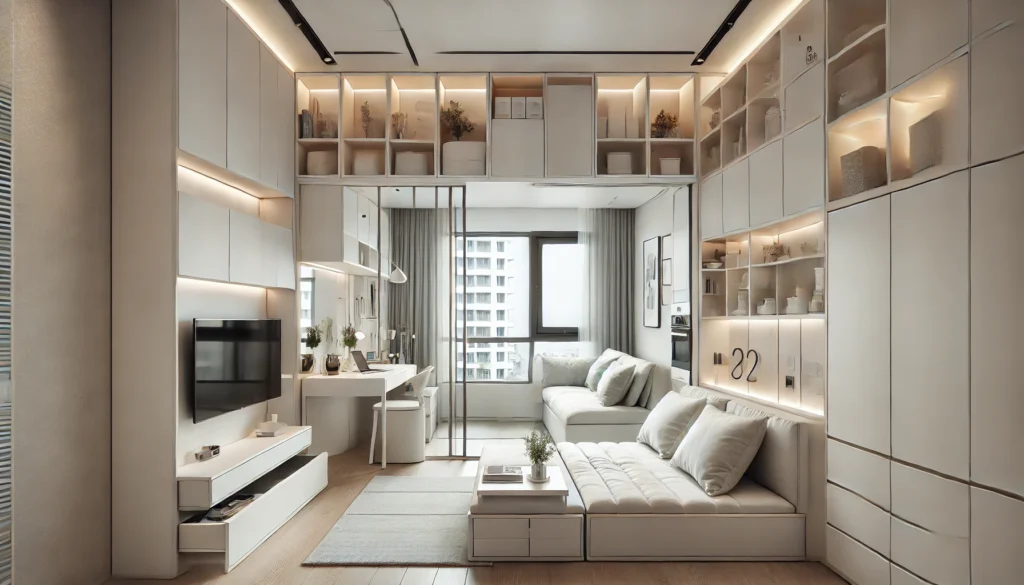
Another transformative technique is the strategic use of mirrors and lighting. Mirrors can create the illusion of a larger area by reflecting light and opening up the room visually. Positioning a large mirror opposite a window can amplify natural light, enhancing the room’s brightness and sense of openness. Similarly, adequate and thoughtfully placed lighting can make a significant difference. Layered lighting, combining ambient, task, and accent lighting, provides both functionality and depth, making even the smallest spaces feel expansive and welcoming.
Design principles for small spaces emphasize simplicity and cohesion. Opting for a light color palette can make a room feel airy and large. Minimalist designs with clean lines help reduce visual clutter and create a harmonious, organized look. Additionally, incorporating natural elements, such as wooden finishes and indoor plants, can add warmth and texture, making the space feel more inviting and lively.
Bold Colors and Patterns
As we move into 2024, interior design trends in Australia are embracing a vivid transformation through bold colors and dynamic patterns. This year, a surge of deep greens, rich blues, and earthy terracotta shades are making headlines, inviting homeowners to infuse their spaces with a newfound vibrancy and character.
Deep greens, reminiscent of lush forests, provide a serene yet striking backdrop, perfect for creating a tranquil living space or bedroom. These shades pair exquisitely with wooden furniture, metallic accents, and neutral tones, ensuring balance and harmony within the interior. Rich blues, on the other hand, embody the calming essence of the coast. Whether applied to walls, textiles, or decorative elements, these hues evoke a sense of calm and sophistication, blending seamlessly with both modern and traditional designs.
Terracotta, a warm and earthy hue, is being celebrated for its ability to add warmth and depth to any room. This versatile color can be employed in various ways, from terracotta wall paints to ceramic decor pieces. When integrated with natural materials like stone and wood, terracotta creates a grounded, inviting atmosphere, ideal for living areas and kitchens.
Incorporating bold colors and patterns doesn’t stop at walls; statement pieces and feature walls serve as focal points, bringing personality and a bespoke quality to interiors. Patterned textiles, such as cushions, rugs, and upholstery, offer an excellent avenue to introduce vibrant designs without overwhelming the space. Think geometric patterns, botanical prints, and artisanal fabrics which can transform the mundane into the extraordinary.
Moreover, mixing and matching patterns while maintaining a cohesive color scheme can elevate interior aesthetics. The key lies in moderation and selecting complementary tones and designs. For instance, a deep green statement sofa paired with patterned terracotta cushions can create a striking yet balanced look. Similarly, a rich blue feature wall adorned with minimalist artwork adds depth and a touch of grandeur.
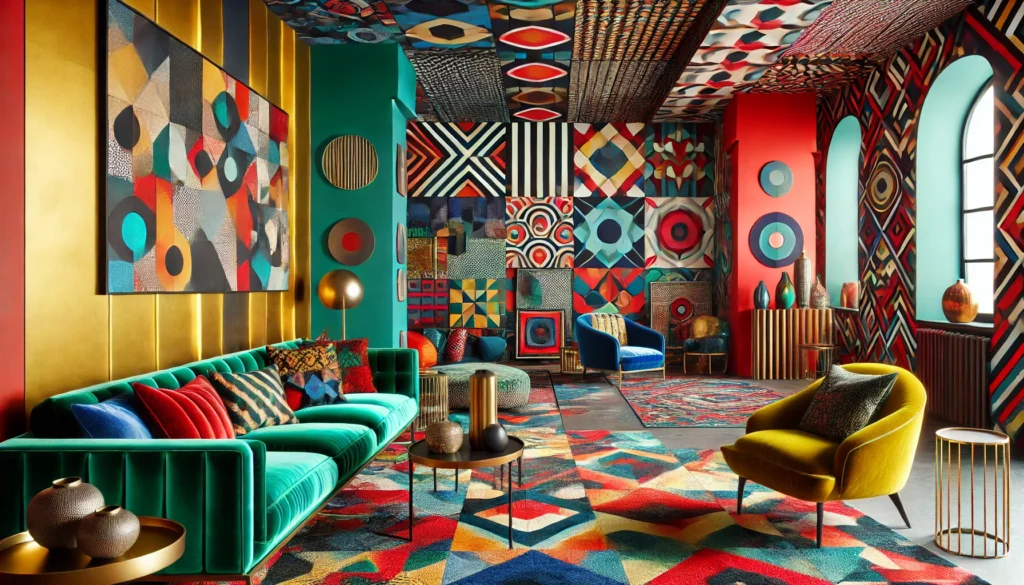
By thoughtfully integrating these bold hues and patterns, interiors can transcend the ordinary, showcasing a curated yet effortless style that is poised to dominate the interior design trends in 2024.
Innovative Technology Integration
Technological advancements are significantly reshaping the landscape of interior design, with smart homes becoming the epitome of modern living. The integration of smart lighting systems is revolutionizing the way spaces are illuminated, offering homeowners the ability to control light intensity, color, and scheduling through smartphone apps or voice-activated assistants. This not only adds unparalleled convenience to daily living but also enhances the overall aesthetic of the home, allowing adaptable lighting that can highlight particular interior design trends and features effectively.
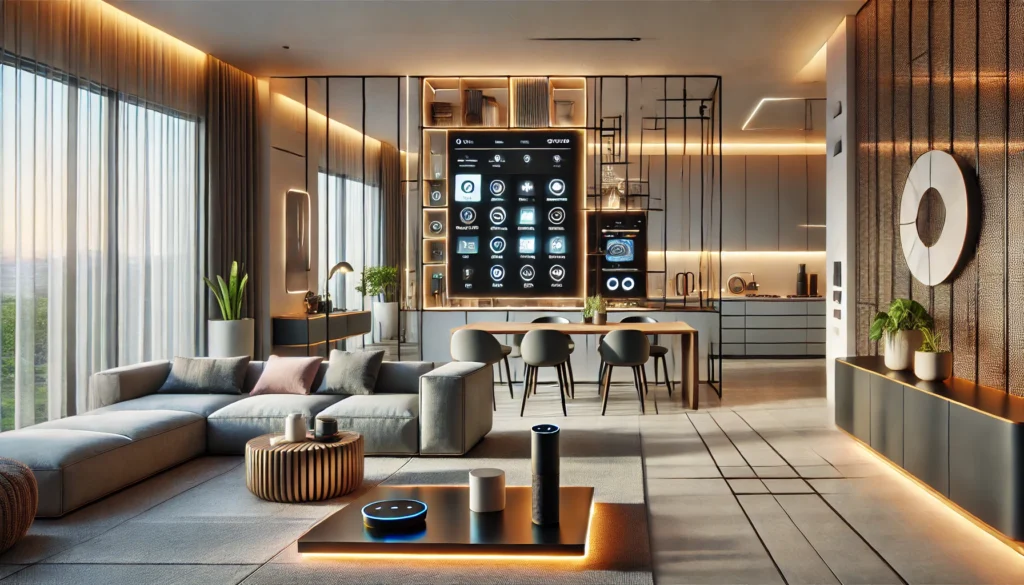
Climate control systems have also seen remarkable innovation, empowering homeowners to maintain optimal temperatures with minimal energy consumption. Smart thermostats that learn user preferences and adjust settings accordingly are becoming a staple in modern Australian homes. These systems not only provide comfort but also contribute to sustainability by reducing energy waste, aligning perfectly with the eco-conscious movement in interior design.
Home automation further integrates into this evolving landscape, offering comprehensive control over various home elements. From automated window treatments that adjust according to the time of day to security systems that provide real-time monitoring, the integration of technology in interior design is creating spaces that are not only functional but also incredibly adaptive. Examples such as voice-controlled blinds, smart mirrors, and connected kitchen appliances offer a glimpse into the future of interior design, where aesthetic meets efficiency.
The latest tech trends are seamlessly blending with diverse design styles, enhancing traditional spaces with modern efficiencies. For instance, rustic interiors can adopt smart climate systems without compromising their charm, while urban chic layouts can incorporate sleek smart mirrors and advanced lighting for a sophisticated edge. As interior design trends continue to evolve, the integration of innovative technology is setting new standards, making homes smarter, more efficient, and more visually appealing.
Personalized and Custom Designs
In the evolving landscape of interior design trends, personalization is taking center stage. Homes are increasingly becoming unique sanctuaries that mirror the individual tastes and lifestyles of their owners. This shift towards customized designs ensures that no two spaces are quite the same. Central to this trend are custom-made furniture, bespoke art pieces, and unique decor items, each crafted to add a personal touch that transforms a house into a home.
One of the key ways to achieve a personalized space is through custom-made furniture. Instead of opting for mass-produced pieces, homeowners are collaborating with designers and craftsmen to create furniture that fits their specific needs and aesthetic preferences. This bespoke approach allows for the selection of materials, colors, and finishes that truly resonate with the homeowner’s vision, ensuring that each piece is both functional and a work of art.
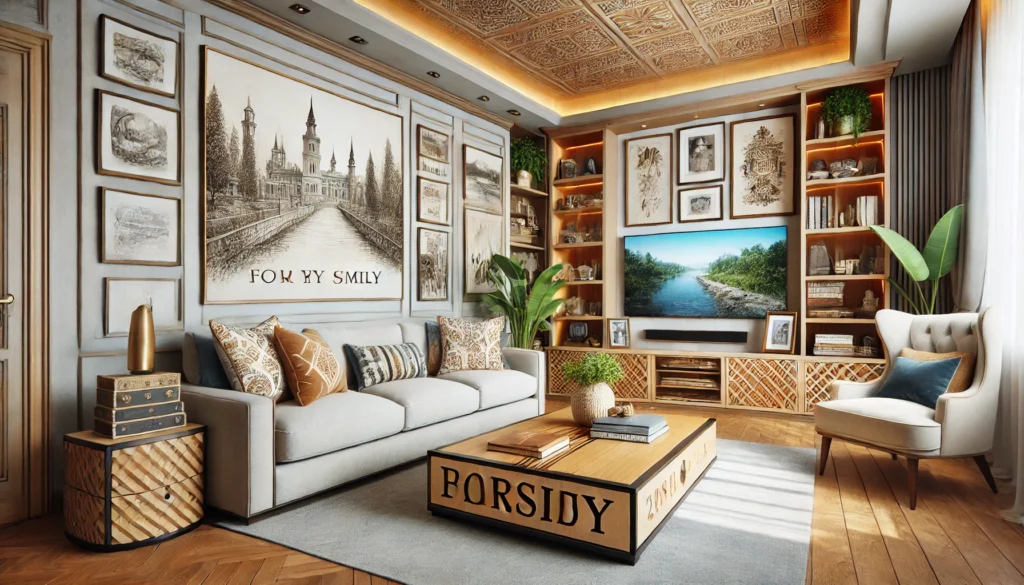
Bespoke art is another element that can significantly enhance personalized interiors. Commissioning original artworks or integrating personalized art pieces brings a distinctive flair to any home. These creations not only serve as conversation starters but also encapsulate personal stories and tastes. From murals and sculptures to handcrafted wall hangings, bespoke art provides an authentic layer of individuality.
To infuse uniqueness into interior spaces, incorporating unique decor items is essential. These can range from family heirlooms to DIY creations that reflect personal hobbies and interests. For instance, a vintage clock inherited from grandparents or a self-made bookshelf can serve as focal points that blend seamlessly with modern designs. By mixing the old with the new, these items foster a sense of continuity and timelessness.
Collaborating with designers is crucial when aiming for personalized interiors. A clear communication of personal preferences, lifestyle requirements, and emotional connections to specific decor elements can guide the design process. This cooperation ensures that the final outcome is a space that feels truly personal and unique.
Incorporating family heirlooms or DIY pieces into modern designs requires a thoughtful approach. These elements should complement, rather than clash with, the contemporary style. Strategically placing these items in prominent but harmonious parts of the home can create a balanced and cohesive look, merging tradition with modernity.
